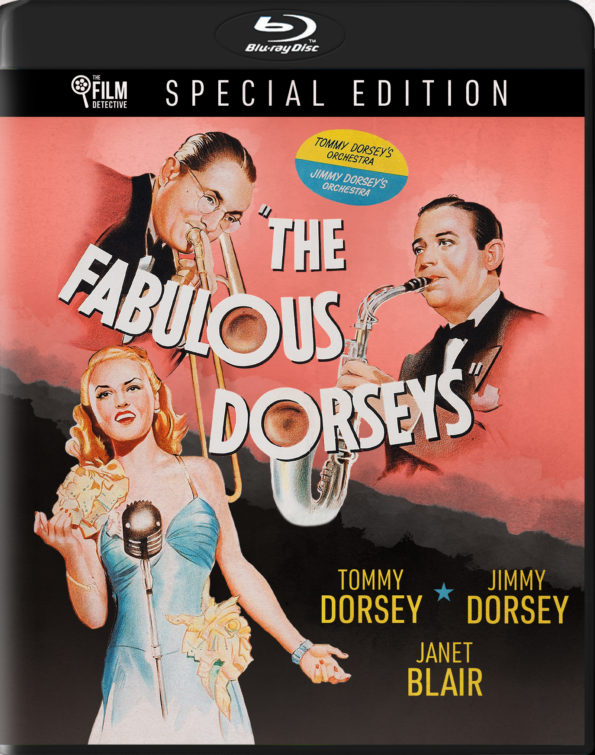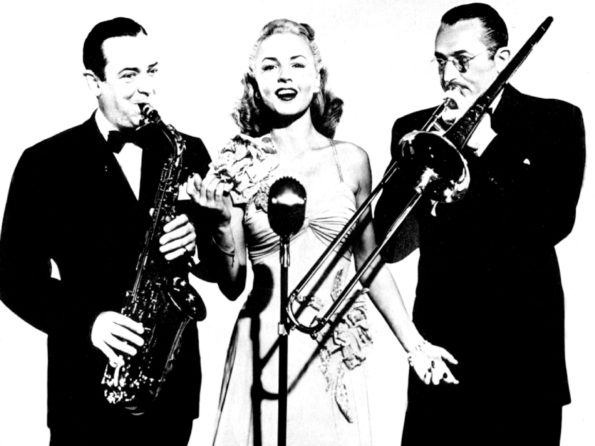Big band leader siblings of the 1940s-50s, Tommy and Jimmy Dorsey, get a nice re-introduction in Cinedigm’s release this week of The Film Detective (TFD)’s restored 1947 black-and-white feature film, “The Fabulous Dorseys,” on Blu-ray ($24.95) as of Dec. 14.

The cinematic life story of the creators of hits such as “I’m Getting Sentimental Over You” and “Tangerine,” notably starred the brothers playing themselves as they establish their career, fight over musical arrangements and styles, break up their partner act, establish successful solo careers, and eventually reunite before each dying within seven months of each other in their early 50s, and all in 87-minutes.
Directed by Alfred E. Green (“The Jolson Story”), the film also stars Janet Blair (“My Sister Eileen) as their childhood friend and lead singer (photo below).

High-profile music greats of the area appear in cameos, including Paul Whiteman, Helen O’Connell, and a jam session featuring the Dorseys and piano legend Art Tatum.
As explained in a trivia-filled audio commentary by Jennifer Churchill, this special restored edition of the film was meticulously cobbled together using the best sections of archival audio elements and film prints from various sources for each scene to create a clean 4K transfer.
Churchill also notes that some copies of the movie show the title as The Fighting Dorseys, which describes the movie but which was changed. She also notes that even though the film makes it appear that Tommy and Jimmy reunited shortly after their father’s death to appease their mother, the brothers didn’t actually reunite until some years later.
An 18-minute bonus featurette from Ballyhoo Motion Pictures, “The Fabulous Forties: Big Bands on Screen,” produced, directed, edited by Daniel Griffith, and written and co-produced by C. Courtney Joyner does a nice job of summarizing the cinematic representation of big bands in their heydey of the 1940s. Hollywood recognized the value of the popularity of the bands and the band leaders and sometimes wrote flimsy stories around musical numbers by the artists. Other films built a few numbers by the bands into their stories. Some clips and examples include Harry James in “Private Buckaroo,” and Abbott and Costello movies that featured Big Band singers like “Buck Privates” (The Andrews Sisters), and “Ride ’em Cowboy” (Ella Fitzgerald).
“This was your opportunity to see these acts in person,” Griffith says in his narration.
In the 12-page booklet inside the Blu-ray sleeve, essayist Don Stradley says that for a band, being in a movie musical in the 1940s was the equivalent of a band getting their music video on MTV in the 1980s.
Stradley also notes that it was the other way around at times — Frank Sinatra’s uncredited film debut was in the 1941 “Las Vegas Nights” as the vocalist for Tommy Dorsey’s performance of “I’ll Never Smile Again.”
Griffith notes in his documentary that band leaders such as Count Basie and Duke Ellington were often the only Black faces in otherwise all-White casts, so it was a good showcase for them.
Warner Brothers found success showing supporting for the war effort (WWII) by featuring Basie, Guy Lombardo, and Benny Goodman (with his featured singer Peggy Lee) in “Stage Door Canteen,” to which only patrons wearing their military uniform would be admitted.
— By Scott Hettrick
